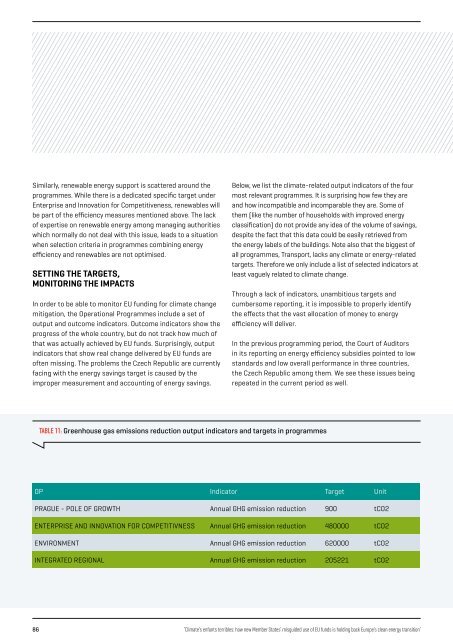ENFANTS TERRIBLES
enfants-terribles
enfants-terribles
Create successful ePaper yourself
Turn your PDF publications into a flip-book with our unique Google optimized e-Paper software.
Similarly, renewable energy support is scattered around the<br />
programmes. While there is a dedicated specific target under<br />
Enterprise and Innovation for Competitiveness, renewables will<br />
be part of the efficiency measures mentioned above. The lack<br />
of expertise on renewable energy among managing authorities<br />
which normally do not deal with this issue, leads to a situation<br />
when selection criteria in programmes combining energy<br />
efficiency and renewables are not optimised.<br />
SETTING THE TARGETS,<br />
MONITORING THE IMPACTS<br />
In order to be able to monitor EU funding for climate change<br />
mitigation, the Operational Programmes include a set of<br />
output and outcome indicators. Outcome indicators show the<br />
progress of the whole country, but do not track how much of<br />
that was actually achieved by EU funds. Surprisingly, output<br />
indicators that show real change delivered by EU funds are<br />
often missing. The problems the Czech Republic are currently<br />
facing with the energy savings target is caused by the<br />
improper measurement and accounting of energy savings.<br />
Below, we list the climate-related output indicators of the four<br />
most relevant programmes. It is surprising how few they are<br />
and how incompatible and incomparable they are. Some of<br />
them (like the number of households with improved energy<br />
classification) do not provide any idea of the volume of savings,<br />
despite the fact that this data could be easily retrieved from<br />
the energy labels of the buildings. Note also that the biggest of<br />
all programmes, Transport, lacks any climate or energy-related<br />
targets. Therefore we only include a list of selected indicators at<br />
least vaguely related to climate change.<br />
Through a lack of indicators, unambitious targets and<br />
cumbersome reporting, it is impossible to properly identify<br />
the effects that the vast allocation of money to energy<br />
efficiency will deliver.<br />
In the previous programming period, the Court of Auditors<br />
in its reporting on energy efficiency subsidies pointed to low<br />
standards and low overall performance in three countries,<br />
the Czech Republic among them. We see these issues being<br />
repeated in the current period as well.<br />
TABLE 11: Greenhouse gas emissions reduction output indicators and targets in programmes<br />
OP Indicator Target Unit<br />
PRAGUE - POLE OF GROWTH Annual GHG emission reduction 900 tCO2<br />
ENTERPRISE AND INNOVATION FOR COMPETITIVNESS Annual GHG emission reduction 480000 tCO2<br />
ENVIRONMENT Annual GHG emission reduction 620000 tCO2<br />
INTEGRATED REGIONAL Annual GHG emission reduction 205221 tCO2<br />
86<br />
‘Climate’s enfants terribles: how new Member States’ misguided use of EU funds is holding back Europe’s clean energy transition’


